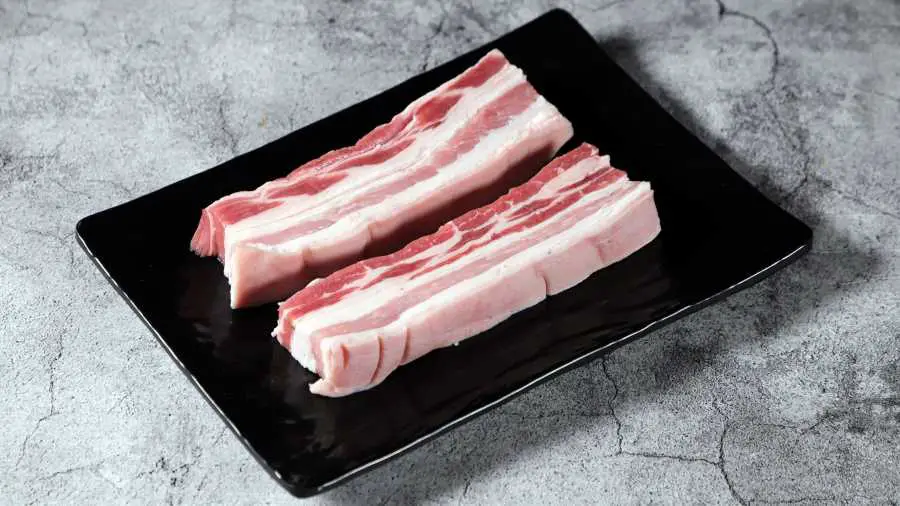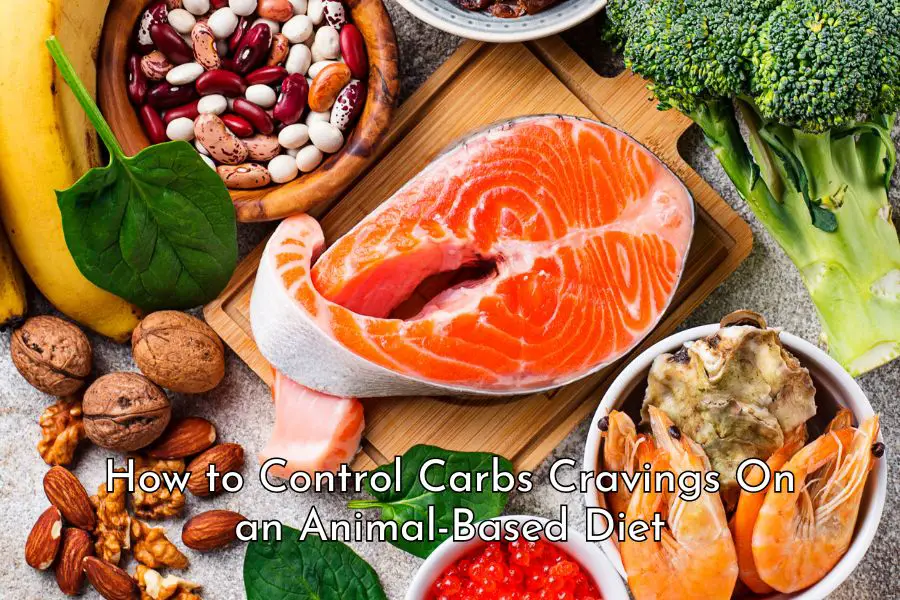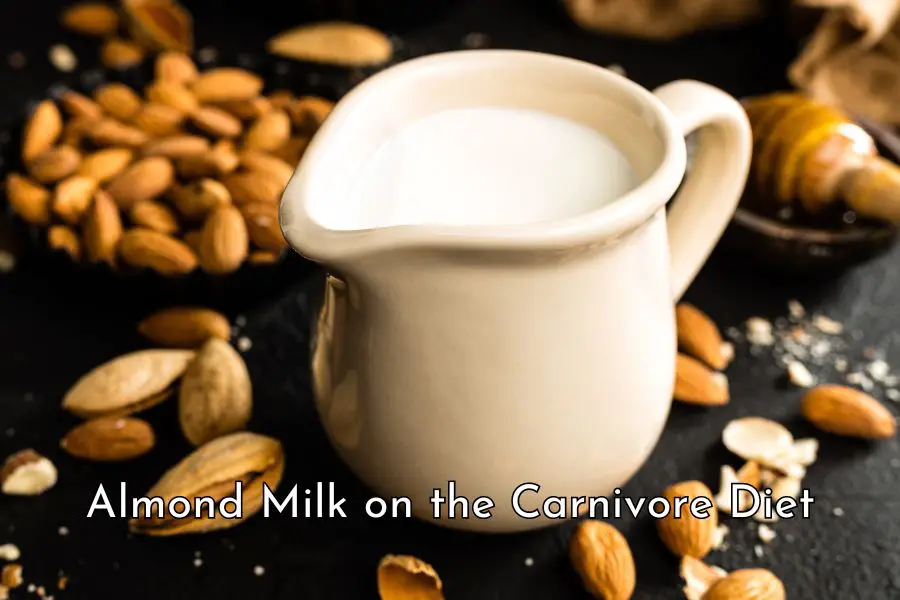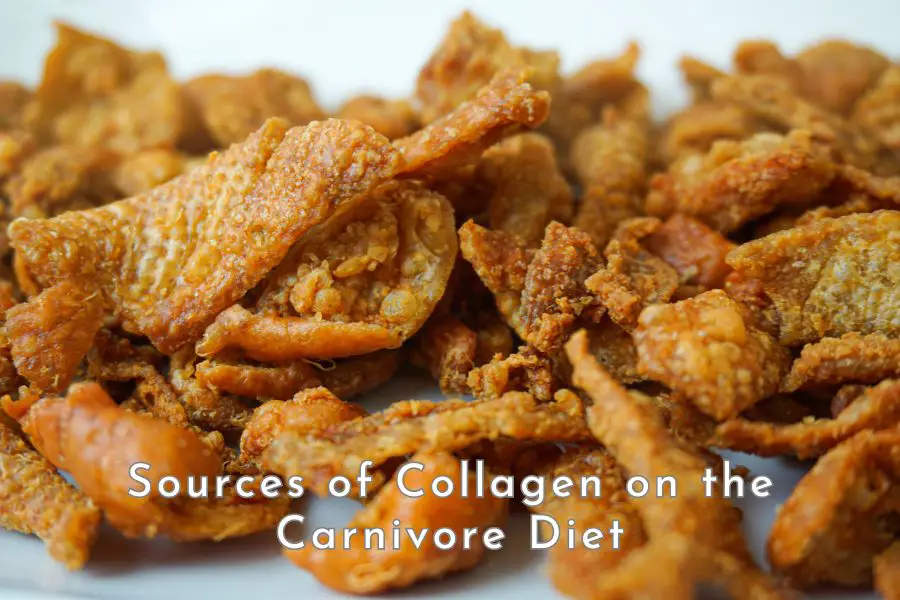Pork is often considered sub-optimal meat on the carnivore diet due to its high omega 6 to omega 3 ratio, however, many people all over the world enjoy pork, especially the delicious bacon and crispy pork belly, and don’t seem to have any apparent problems.
So, what is the verdict for pork?
Having looked at pork’s nutritional profile, in my opinion, pork is highly nutritious and if you feel good eating it and can get pasture-raised pork, enjoy pork as much as you like on the carnivore diet.
The main problem people have with pork seems to be the high omega 6 content in conventional pork that may be inflammatory. This can be addressed by choosing pasture-raised pork or wild boar meat which has a much lower omega 6 content and a better omega 6 to omega 3 ratio.
Another problem for some people could be the way fresh pork is cooked. A small study has found that consuming un-marinated cooked pork induced blood clotting after eating. This may interfere with blood circulation and cause fatigue and other unpleasant feelings after eating pork. If you experience the same problem, it can be easily fixed by marinating.
However, overall beef and other ruminant meat would be a better choice compared to pork because ruminants are generally better raised and have a better nutritional profile than conventional pork.
The ultimate determinant of what you can or should eat on the carnivore diet is always your health and the only way to find out is to test out pork and see how you feel.
In the section below, we will look at pork’s overall nutritional profile, its fatty acid profile and why ruminant meat is generally a better choice than pork, even pasture-raised pork.
We will also look at a small study by the Weston Price Foundation that found unmarinated cooked pork caused blood clotting which might explain why some people don’t feel well after eating pork.
Pork is highly nutritious
As can be seen in the table below, pork is very nutritious.
It is high in good quality protein and rich in a wide range of vitamins and minerals. It is especially high in thiamin, riboflavin, niacin, vitamin B6, vitamin B12, phosphorous, zinc and selenium.
Overall, pork nutrients are comparable to that of beef and lamb, slightly higher than beef and lamb in some nutrients (e.g. thiamin, niacin, vitamin B6, magnesium, phosphorous, selenium) but lower in other nutrients.
However, its omega 6 to omega 3 ratio is substantially higher than beef and lamb which we will explore further in the next section.
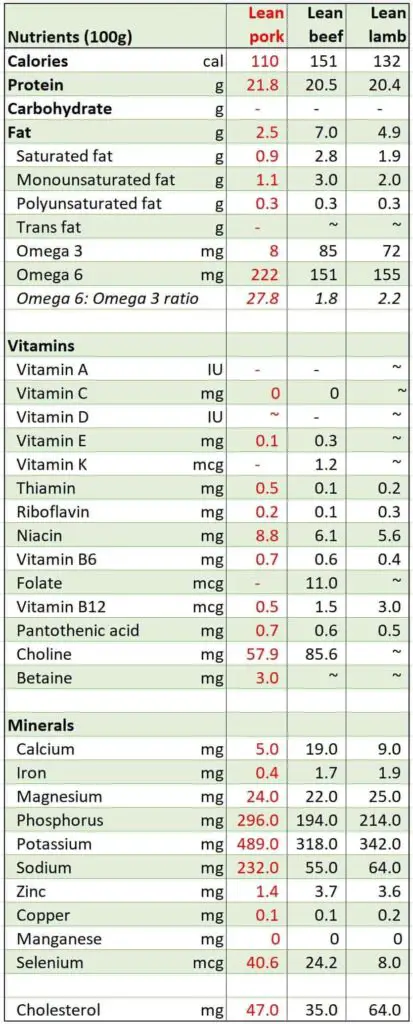
Pork fat is high in polyunsaturated fat
As can be seen in the table below, pork fat is high in polyunsaturated fat compared to beef and lamb fat.
One hundred grams of pork fat has 10.2 grams of polyunsaturated fat compared to 2.6 grams and 2.8 grams for beef fat and lamb fat respectively.
Pork fat’s omega 6 to omega 3 ratio of 21.8 is also extremely high compared to only 1.4 and 2.1 for beef fat and lamb fat respectively.
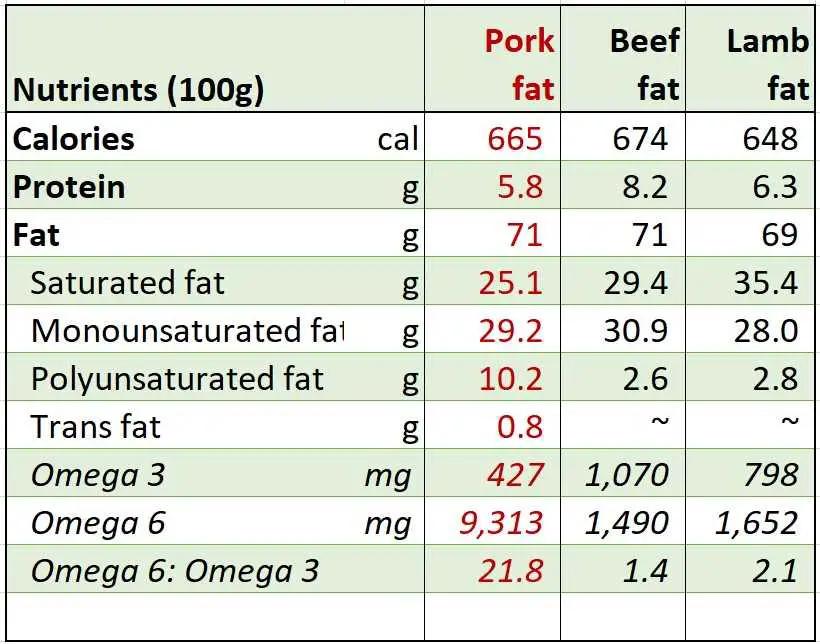
Our ancestors are thought to have consumed a diet with an omega 6-to-omega 3 ratio of approximately 1:1 and beef fat and lamb fat have ratios much closer to this ideal ratio than pork fat. [1]
The reason why a high level of polyunsaturated fats in pork makes people shun away from it is that polyunsaturated fats are linked to many chronic inflammatory diseases such as nonalcoholic fatty liver disease, cardiovascular disease, obesity, inflammatory bowel disease, rheumatoid arthritis, Alzheimer’s disease, and cancer. [2, 3]
A randomized controlled trial called Sydney Diet Heart Study conducted from 1966 to 1973 involving 458 men with a recent coronary event found that “substituting dietary linoleic acid [a polyunsaturated essential fatty acid found mostly in plant oils] in place of saturated fats increased the rates of death from all causes, coronary heart disease, and cardiovascular disease“.[4]
The intervention group that was advised to replace saturated fats with omega 6 linoleic acid from safflower oil and safflower oil polyunsaturated margarine had higher rates of death than the control group.
If polyunsaturated fats are your main concern about pork, try to get pasture-raised pork which has been found to have a much better omega 6 to omega 3 ratio compared to conventional pork.
A small study has found that pasture-raised pork has much better omega 6 to omega 3 ratios compared to factory-farmed pork. In particular:[5]
- conventional factory-farmed pork’s ratio was 29:1
- pasture-raised pigs fed with grains’ ratio was 14:1
- pasture-raised pigs fed with 50% reduced grains’ ratio was 10:1
- pasture-raised pigs fed no grains at all was an impressive 5:1.
Why ruminant meat is generally a better choice than pork
Overall, ruminant meat is still a better meat choice than pork because:
- Ruminant meat is closer to what our ancestors used to eat. For millions of years, our ancestors dined on large herbivores and drove them to extinction. The closest you can get to large herbivores these days are ruminants like bison, cows, elks, and buffaloes, not pigs or chickens.[6]
- Ruminants like cows and sheep are generally better raised than pigs:
- Beef cattle, for example, still spend most of their lives outdoor grazing and eat a diet relatively close to their natural diets. While farmed ruminants are also fed grains, corn or soy meals at feedlots before slaughter, polyunsaturated fats in their feed don’t end up in ruminant fats like pigs or poultry do.
- Pigs raised for meat in factory-farmed operations generally spend their entire lives in barren crates or concrete pens. They are also not fed a species appropriate diet. They are generally on a grain-based diet consisting of corn, soybean, wheat, barley, and oat, which is unnatural relative to what they would have eaten in the wild [7, 8, 9]
- Ruminant meat and fat have a better fatty acid profile than pork. As shown above, beef and lamb fat, for example, has the omega 6 to omega 3 close to 1 which is the approximate ratio of our ancestors’ diet. Meanwhile, conventional pork’s ratio is above 20 and pasture-raised pork’s ratio is around 5. Because pigs have single stomachs, they are unable to convert dietary polyunsaturated fatty acids into saturated fats like ruminants do.
Fresh pork meat may cause blood coagulation
The Weston Price Foundation carried out an interesting study in relation to the impact of consuming un-marinated pork on blood.[10]
In this small study, three normal healthy adults who had been eating a traditional Weston Price Foundation diet for over two years were given five different preparations of pork:
- Unmarinated pastured center-cut pork chop, cooked for up to one hour
- Apple cider vinegar-marinated (twenty-four hours while refrigerated) pastured center-cut pork chop, cooked for up to one hour
- Uncured pastured prosciutto, uncooked
- Uncured pastured bacon, cooked until slightly stiff but not crisp
- Unmarinated pastured lamb chop, cooked for up to one hour.
All subjects came to the laboratory once a week for five weeks. On the days in which they participated, subjects were required to fast for at least five hours. Blood samples were drawn before meals and 5 hours after meals.
The blood analysis results show that five hours after consumption of unmarinated pork chops, all subjects showed “extremely coagulated blood, with extensive red blood cell rouleaux (cells in the formation of stacked coins), red blood cell aggregates, and the presence of clotting factors, especially fibrin“.
As can be seen in the images below, only after consuming unmarinated pork chops that red blood cells were entirely stuck together and this blood coagulation can disrupt the microcirculation.
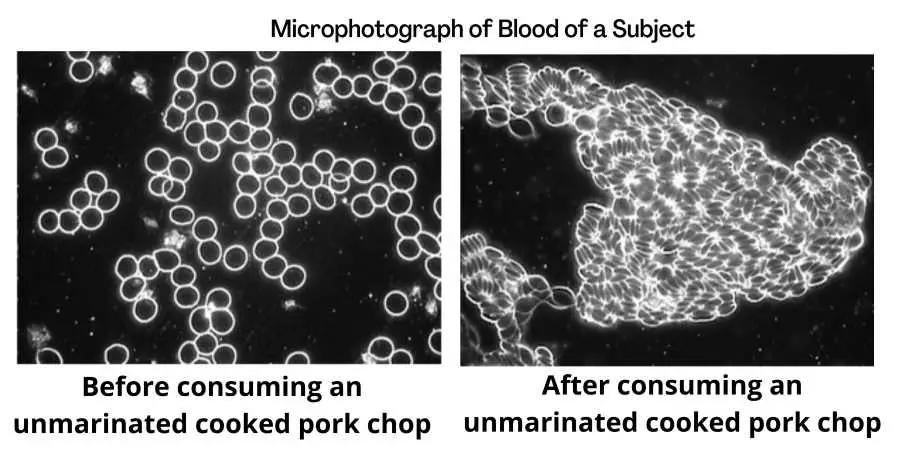
The microphotographs of the blood of the subjects after consuming marinated pork chops, unmarinated lamb chops, uncured pasture-raised bacon and uncured pasture-raised prosciutto all appear normal and healthy.
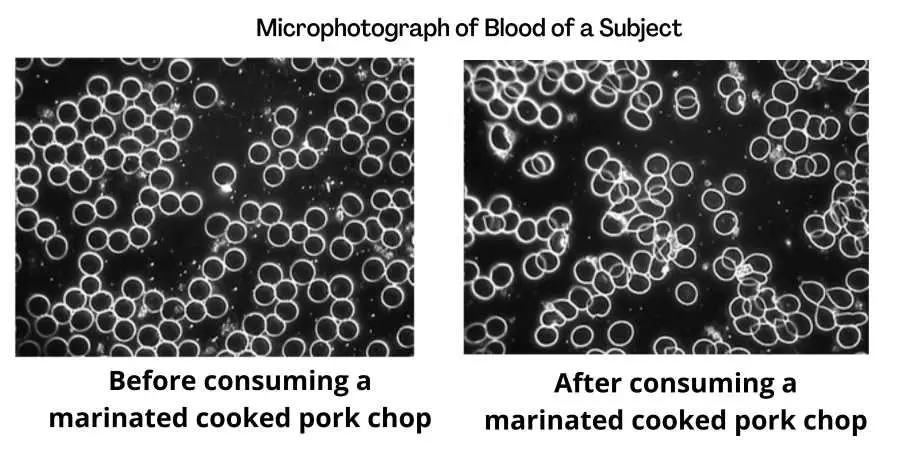
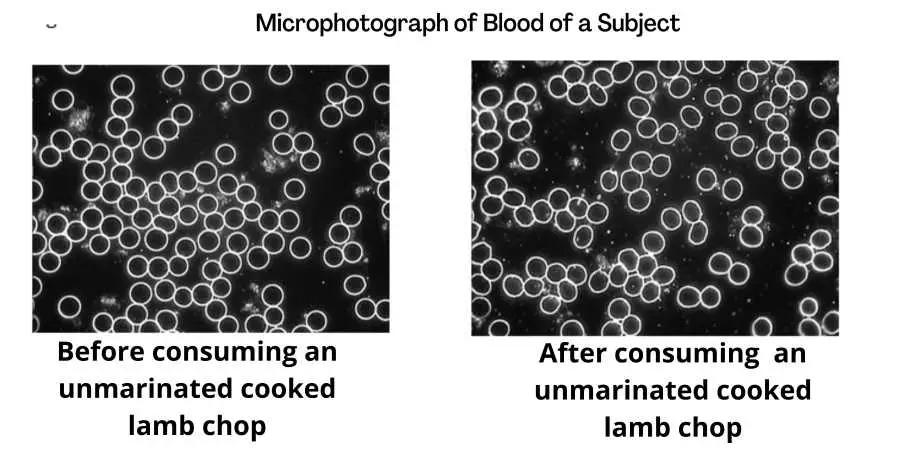
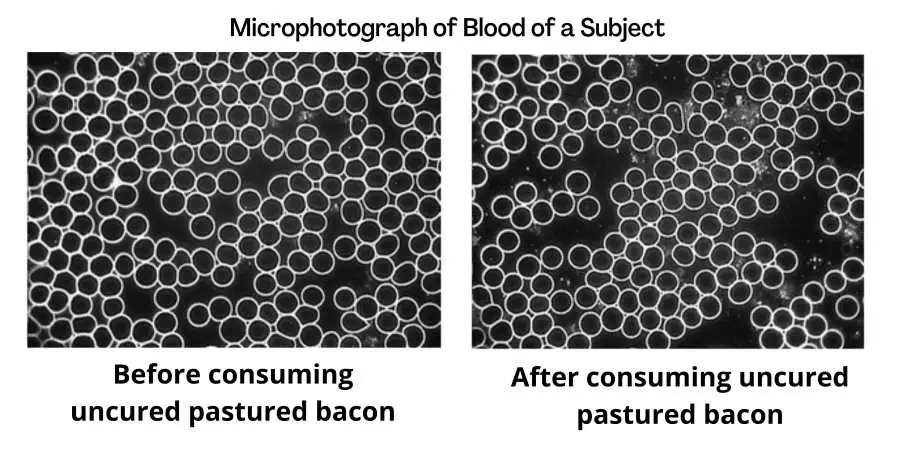

Two subjects also complained of fatigue after eating the unmarinated pork chop suggesting reduced peripheral blood circulation due to red blood cell stickiness and aggregation.
The authors of the study speculate that raw pork might contain an unidentified toxin that heat doesn’t destroy but a combination of heat and fermentation with salt and acid does.
While many people in the carnivore diet community find that they don’t feel satiated and well after eating pork like with beef, a few studies on pork consumption have not found any particular problem with it.[11, 12, 13]
Some people also find that their blood sugar increases after consuming pork but research into this topic is very limited and there is a lack of solid evidence that pork consumption specifically affects metabolic health. [14]
If you find you have problems with pork even the pasture-raised pork, experiment with marinating it overnight in vinegar and salt to see if it can be resolved.
Should pork be part of your carnivore diet?
Overall, ruminant meat like beef and lamb is a better choice than pork and I highly recommend making ruminant meat, ruminant fat and ruminant organs the staple of your carnivore diet.
However, if you enjoy pork, don’t have any problem with eating it, and can afford to get pasture-raised pork or wild boar meat, I would say eat as much pork as you like.
Pasture-raised pork not only has a more favorable fatty acid profile, it also tastes better and is also richer in other nutrients. For example, a study has found that pasture-raised pigs have 300% more vitamin E and 75% more selenium in their milk than factory-farmed pigs.[15]
The ICMNI center in Hungary which has been using a high-fat animal-based diet to treat many chronic diseases recommends eating meat, organs and fat from 4-legged animals and pork is included but it should come from ecological farms. This is understandable because Hungary is a major pork producer in Europe and pigs there are generally better raised than their American counterparts.
If you can only get conventional pork, maybe have it on occasion only.
If conventional pork is all you can afford or get access to, it is still way better than bread, rice, beans, burgers, pizzas, or fish and chips. So, don’t let the perfect be the enemy of the good.
Hong Kong, a country with the highest life expectancy in the world, also has one of the highest meat consumption per capita in the world (664g/day/capita) and Hong Kong people happen to eat a lot of pork.[16, 17]
If you do eat a lot of conventional pork, I recommend getting lean cuts and try to add ruminant fats as well as oily fish which is high in omega 3 (e.g. salmon, sardines, trout, herring, and cod) to improve the overall omega 6 to omega 3 ratio of your diet.
In light of the research into unmarinated pork mentioned above, try to eat fresh pork and experiment with marinated and unmarinated pork to see if that makes any difference to how you feel.
It’s best to stay away from all kinds of processed pork meat or have it very sparingly, especially those with preservatives and other additives.
If you find this post helpful, please consider sharing this post and my site with your family, friends, and followers. That would be much appreciated. Please also check out my library of articles on the carnivore diet here which is updated regularly.
Disclaimer: The information in this post is for reference purposes only and not intended to constitute or replace professional medical advice. Please consult a qualified medical professional before making any changes to your diet or lifestyle.

